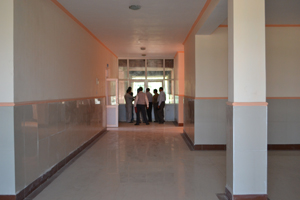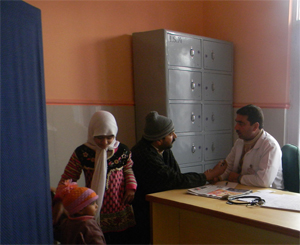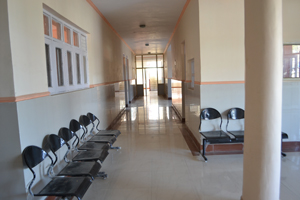unani Hospitals
Molejat (Medicine)It includes treatment in general from minor ailments to even complicated diseases like Jaundice. All diseases of respiratory system,Digestive system,circulatory system,Musculo-Skeletal system, male and female uro-genital system ,skin and sexual disorders are duly covered by the Molejat Unit of the hospital.
 JARAHAT (Surgery): This hospital plans to provide treatment under surgical unit for various minor surgical procedures as the hospital is located on National Highway.Besides, Trauma and emergency unit will be established soon to meet the demands of common masses.
JARAHAT (Surgery): This hospital plans to provide treatment under surgical unit for various minor surgical procedures as the hospital is located on National Highway.Besides, Trauma and emergency unit will be established soon to meet the demands of common masses.
SPECIALIZEDTREATMENT THROUGH REGIMENTAL THERAPIES
Regimental Therapy (ILAJ-Bil-TADBEER)
Ilaj-Bil-Tadbeer (Regimental therapy) is one of the four methods of treatment in the Unani system of medicine. The other three methods are Ilaj-Bil-Ghiza (Dietotherapy) Ilaj-bil-Dawa (Pharmacotherapy) and Ilaj-bil-Yad (Surgery).
Literally Tadbeer is an Arabic word meaning Regimen (Systemic plan) whereas Ilaj means therapy or treatment. So Ilaj-Bil-Tadbeer means treatment through regimen, which is a method, through which care of the sick person and maintenance of general health is performed with the help of certain procedures, tools and equipments described by eminent Unani physicians e.g. Buqrat (Hippocrates), Jalinoos (Galen), ZakariaRazi (Rhazes), IbneSina (Aviccena) and Abu-al-QasimZahrawi (Abulcassis)
Ilaj-Bil-Tadbeer is used independently or in combination with other methods of treatment like IlajbilDawa (Pharmacotherapy), IlajBilghiza (Dietotherapy) and IlajBilYad (Surgery). Ilaj-BilTadbeer (Regimental Therapy) consists of Hijamat (cupping), Fasd (venesection), Taleeq (leeching), and Kai (cauterization).
 Riyazat (Exercise):- Riyazat is a voluntary movement with the purpose of Tanqiya-e-Mavad (evacuation of waste material) for an individual. It plays an important role not only in maintaining good health and prevention of diseases but in curing certain ailments as well.
Riyazat (Exercise):- Riyazat is a voluntary movement with the purpose of Tanqiya-e-Mavad (evacuation of waste material) for an individual. It plays an important role not only in maintaining good health and prevention of diseases but in curing certain ailments as well.
The objective of performing Riyazat are enumerated below:
To improve Istehala (metabolism) for proper functioning of body.
Dalak (Massage or Friction):-Dalk is a systematic manipulation of body tissues with the hands. Several varieties of Dalk have been recommended in Unani system of Medicine e.g. Dalak e sulb (hard), Dalak e layyan (soft), etc. prolonged or moderate massages. Hard friction or massage is Mufatteh-e-Sudad (deobstruent) and makes the body firm. Soft massage is sedative and relaxes the body while prolonged massage reducess the fat of the body; moderate massage develops the body as well as improves and maintains blood circulation of the particular organ; rough friction with a rough cloth enhances vasodilation of the particular organ etc
The objective of performing Dalk are enumerated below:
Takmeed (Fomentation):-Takmeed is the process, which keeps the body or part of the body warm.
The objective of performing Takmeed are enumerated below
Nutool (Pouring of medicated water):-Natool (Pouring of medicated water) is a procedure in which the affected part is washed by a stream of water or medicated decoction from a height. Natool (Irrigation) is done with the purpose of acceleration of Ikhraaj-e-mawaad (excretion of morbid material) and Tabdeel-e-Mizaj-e- a’za (alteration of the temperament of an organ)
The objective of performing Nutool are enumerated below
Zimaad/ Tila (Medicated Paste/ Liniments):-
Tila (Liniments): a kind of medicated oil used externally for massage whereas
Zimaad (medicated paste): semisolid preparations of the crude drugs in powder forms used for local application.
The objectives of Zimaad/ Tila are given below:
Tareeq (Sweating):-Tareeq (Sweating or diaphoresis) is the process to acceelrate the secretions of the sweat glands of the skin.
The objectives of Tareeq are given below:
Idrar-e-baul (Diuresis):-Idrar-e-baul (Diuresis) is one of the important process for evacuation. Specific methods as well as drugs have been mentioned in classical Unani literature to achieve the target.
The objectives of Idrar-e-baul are given below:
 Hammam (Bath):- Hamam produces heat & spreadswarmth. It is a place used for bathing, consisting of several rooms with one room leading to the other with specific provisions and conditions customized according to the disease to be treated.It evacuates the waste materials from the body in the form of sweat and vapours.The people of Turkey were the first to construct the concept of Hamam which was named as Turkish Bath.
Hammam (Bath):- Hamam produces heat & spreadswarmth. It is a place used for bathing, consisting of several rooms with one room leading to the other with specific provisions and conditions customized according to the disease to be treated.It evacuates the waste materials from the body in the form of sweat and vapours.The people of Turkey were the first to construct the concept of Hamam which was named as Turkish Bath.
Hamam is a type of bath in which a bather sweats freely in a room heated by hot dry air in a series of two or three rooms maintained at progressively higher temperatures,usually followed by a cold plunge,a full body wash and massage and a final period of relaxation in a cooling room.
The objectives of Hamam are given below:
Ishaal (Purgation):-
Ishaal is the process used for expulsion of the waste matter through the bowels.
The objectives of Ishaal are given below:
Qai (Emesis):-Qai (emesis) is the evacuation of gastric contents through mouth. The main purpose of vomiting is to eliminate toxic/morbid material from the gastro-intestinal tract.
The objectives of Qai are given below:
Huqna (Enema):-
Huqna (enema) is an excellent process for the removal of superfluities from intestine. In which, liquefied drugs are introduced per rectum by an instrument. This is one of the best methods for elimination of vitiated humors and waste material from the intestine.
The objectives of huqna are given below:
Imala (Diversion of morbid material):-
Imala means ‘diversion’ of matter from one part of the body to another. For this purpose, different techniques are used for treatment of conditions where Imtala-e-Damvi (hyperemia) causes certain problems.
Through this method, the flow of matter is diverted to the other side. As a result, the congestion of the affected part is reduced in a natural way.
The objectives of Imala are given below:
Hijamat (Cupping):-
Hijamat (cupping) is a method of using glass or plastic cups to create localized pressure by a vaccum.
Different cupping sets are used to create vaccum by suction method.Thevaccum inside the cups causes blood to form in the area and help the healing in that area.
Cupping works as per two concepts.
Cupping therapy is beneficial in following conditions:
1.Backpain
2.Sciatica
3.Arthrittis
4.Headache
5.Constipation
6.Fatigue
7.Weight problems
Fasd (Vivisection/Bloodletting):-
Fasd is a procedure in which an incision is given to any of the superficial veins, and blood, containing Madda-e-Fasida (waste material) is allowed to flow. The purpose is evacuation of Madda-e-Fasida (waste material). It removes excess humours in the same proportion as present in the blood vessels or the abnormal humour or both. It is applied for purification of vitiated humors in Sarsaam (Meningitis), Zaat-ur-Riya (Pneumonia), Zaat-ul-janb (Pleurisy), IrqunNisaa (Sciatica), Niqras (Gout), Waja-ulMafasil (Rheumatic Arthritis), Subat Coma, Maalekholia (Melancholia), Khunaaq-e-wabaai (Diphtheria), Bawaseer (Piles), Nisyaan (Amnesia), Waja’-ul-Qalb (Angina Pectoris) etc.
The objectives of Fasd are given below:
Leeching ( IrsaleAlaq)
IrsaleAlaq (Leech therapy or Hirudo therapy) is one of the most important and widely practiced methods of regimental therapy in which live leeches are used for local evacuation of morbid humours. It has been suggested and successfully practiced by Unani physicians in the management of number of disorders. This therapy is known from last 2500 years and is still alive. This fact testifies that this method of treatment is effective. In the recent past the interest in leeching grew more and it has now become part of medical care. However, modern leeching differs from the ancient one as wild leeches are no more used. The Leeches are now grown in specialized leech farms. There are a number of species of leeches but commonly used species for medicinal purpose are Hirudinariamedicinalis, Hirudinariaasiatica, Hirudinariamanellensis.
The effects of leech therapy are attributed to the activities of number of pharmacologically active substances deposited by leeches at the site of bite. The saliva of leech contains about 100 pharmacologically active substances including anticoagulant like hirudin, calin, inhibitors of kallikrein, hyaluronidase, histamine-like vasodilators, collagenase and poorly characterized anaesthetics and analgesic compounds. These substances are injected into human body while sucking of the blood and are responsible for the analgesic, anti inflammatory and anaesthetic effects of leech therapy.
Indications of Leeching
Kai (Cauterization):-
Cauterization is an effective method of treating several conditions e.g. destructive lesions, removal of putrefactive matter and bleeding etc. Unani physicians have preferred mikwa (cauterant) made of gold.
The place to be cauterized must be visible so that the cauterization is done satisfactorily after good observation. However, in the case of deep located organs e.g. mouth, nose and anus, suitable speculum is required. It should be coated with talcum and Armenian bole, soaked in vinegar, wrapped with a piece of cloth. The speculum should be subsequently cooled with rose water or several other juices
The objectives of Kai are given below:
Other facilities:
YOGA AND NATUROPATHY CENTRE
A full-fleged Yoga and Naturopathy centre has been kept in the hospital premises to promote the preventive and promotive healthcare concept .Different Yoga exercises are being taught to patients for different ailments.
PANCHKARMA AND KSHAR-SUTRA THERAPY:
PANCHAKARMA----The term panchakarma is derived from the combination of two words PANCH and KARMA which means five procedures.Panchakarma is basicaly a group of five bio-cleansing procedures which purifies the various systems of the body and evacuates the cumulated toxic metabolitites from human body therby maintaining the normal functioning of th tissues, sense organs and mind.The five panchakara procedures are:-
1. Vamana--Therapeutic Emesis
2. Virechana--Therapeutic Purgation.
3.Anuvasan Vasti---Oil Enema
4. Asthapan Vasti--Decoction Enema
5.Nasya---Snufing.
The panchakarma eradicates the root cause of the diseases and is very effctive in the management of Neurological disorders such as Hemiplegia,Paraplegia,MND, Bells Palsy, GIT Disorders ,Rheumatoid disorders,Osteo arthritis, other joint diseases, Pains , Skin disorders, Insomnia, Loss of memmory, Infertility,Sexual disorders, COPD,Asthama,for delaying the aging process, premature greying of hairs,rejuvenating the body and mind.Panchakarma procedures have scientificaly been proved very effective in the management of acute as well as chronic diseases.
Khsharsutra---A combination of two words KHSHAR=Alkaline SUTRA=Thread which means an Alkaline thread.It is a para surgical technique in which a specialy prepared alkaline Medicated Thread is used in the management of Ano-rectal diseases in particular such as Fistula in ano,Fissure in ano, Haemorhoidsetc.Khsharsutra technique is also used in the management of certain benign growths on skin.
